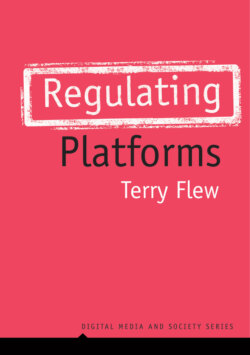Читать книгу Regulating Platforms - Terry Flew - Страница 20
Openness as Public Policy: Safe Harbour and the Communications Decency Act 1996
ОглавлениеA characteristic feature of the politics surrounding internet regulation was therefore a considerably greater concern with the potential obstruction of free speech rights than with the role that policy was likely to play in shaping the political economy of the internet or the economic structures of the wider society. While in the United States the Telecommunications Act 1996 was adopted by the Clinton administration with relatively little contention – and indeed would become a template for new legislation in other parts of the world, as the UK government’s Communications Act 2003 illustrates (Freedman, 2008) – the associated Communication Decency Act 1996 (CDA), which set restrictions upon the online distribution of ‘offensive’ content, faced far more organized opposition.
Although the CDA was signed into law by President Clinton, the American Civil Liberties Union (ACLU), the Electronic Frontiers Foundation (EFF), and other bodies had the legislation struck down in district court, in June 1996 in Pennsylvania, on the grounds that it was a threat to freedom of speech, which was constitutionally guaranteed under the First Amendment, and could have the consequence of ‘chilling’ lawful speech or conduct. In his concluding remarks striking down the legislation, Judge Dalzell argued for the distinctiveness of the internet as a uniquely speech-enhancing medium: in his view, the internet’s seeming chaos and cacophony of speech were in fact its greatest assets, so that to restrict them in response to concerns about pornography or offensive speech was like ‘burning down the global village to roast the pig’. Rather than viewing the internet as a communications medium, Dalzell described it as ‘a never-ending worldwide conversation’ and claimed that, ‘as the most participatory form of mass speech yet developed, the Internet deserves the highest protection from governmental intrusion’ (Judge Dalzell, quoted in Godwin, 1998, p. 289).
The US approach to internet governance was certainly not the only existing one. China, for example, chose to maintain strict controls over internet content, developing the Great Firewall – a system of monitors designed to regulate the content available to Chinese users and to restrict the access of foreign companies to the domestic market. In other countries such as Singapore and Malaysia a relatively open internet was promised in order to encourage international investment, while laws were maintained over speech that service providers would be ‘encouraged’ to commit to. In Australia, the Broadcasting Services Act 1992 was extended to internet content, thereby giving administrative oversight of online content to the Australian Communications and Media Authority, as a convergent regulator (Australian Law Reform Commission, 2012).
The most enduring legacy of the CDA and of the manner in which it was struck down has been the separation of the legal obligations of companies that primarily engage with the public through the internet from the legal obligations of organizations that are conceived of as media companies, in a more traditional sense. The ‘safe harbor’ provisions enshrined in Section 230 of the CDA have given technology and social media companies considerable latitude over how they manage content hosted on their sites, without the liabilities associated with being publishers or media companies. It enshrines a distinction between the internet and ‘the media’ that has continued to prevail in discourses and policies related to the internet; and these are quite different from the original concerns about whether pornography or radical speech had constitutional protection under US law. The European Union’s e-Commence Directive, adopted by member states in 2000, followed the US model in setting clear limits to the liability of internet intermediaries for the content they host, although in practice the safe harbour provisions have been less clear in their application in Europe than in the United States (Keller, 2018).
